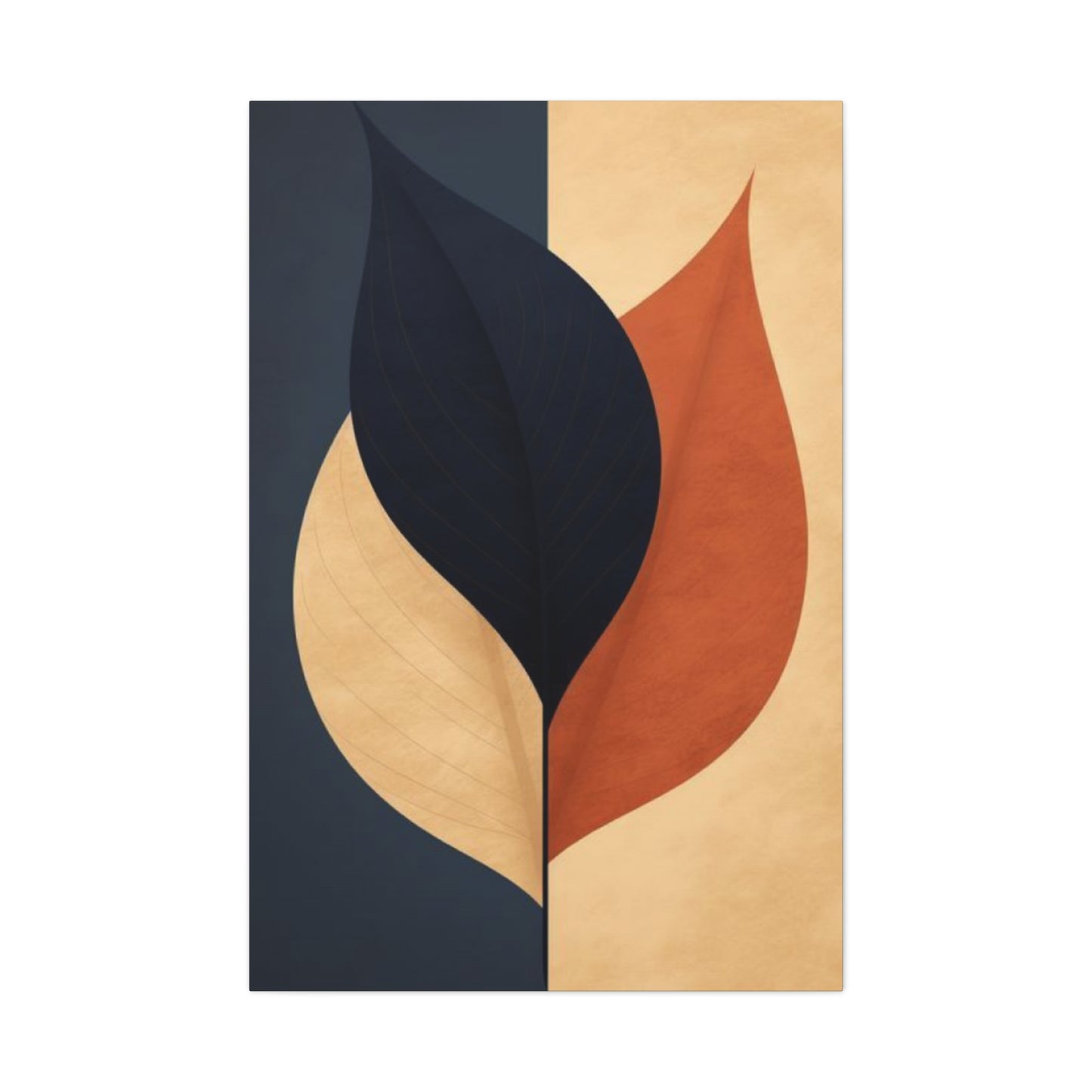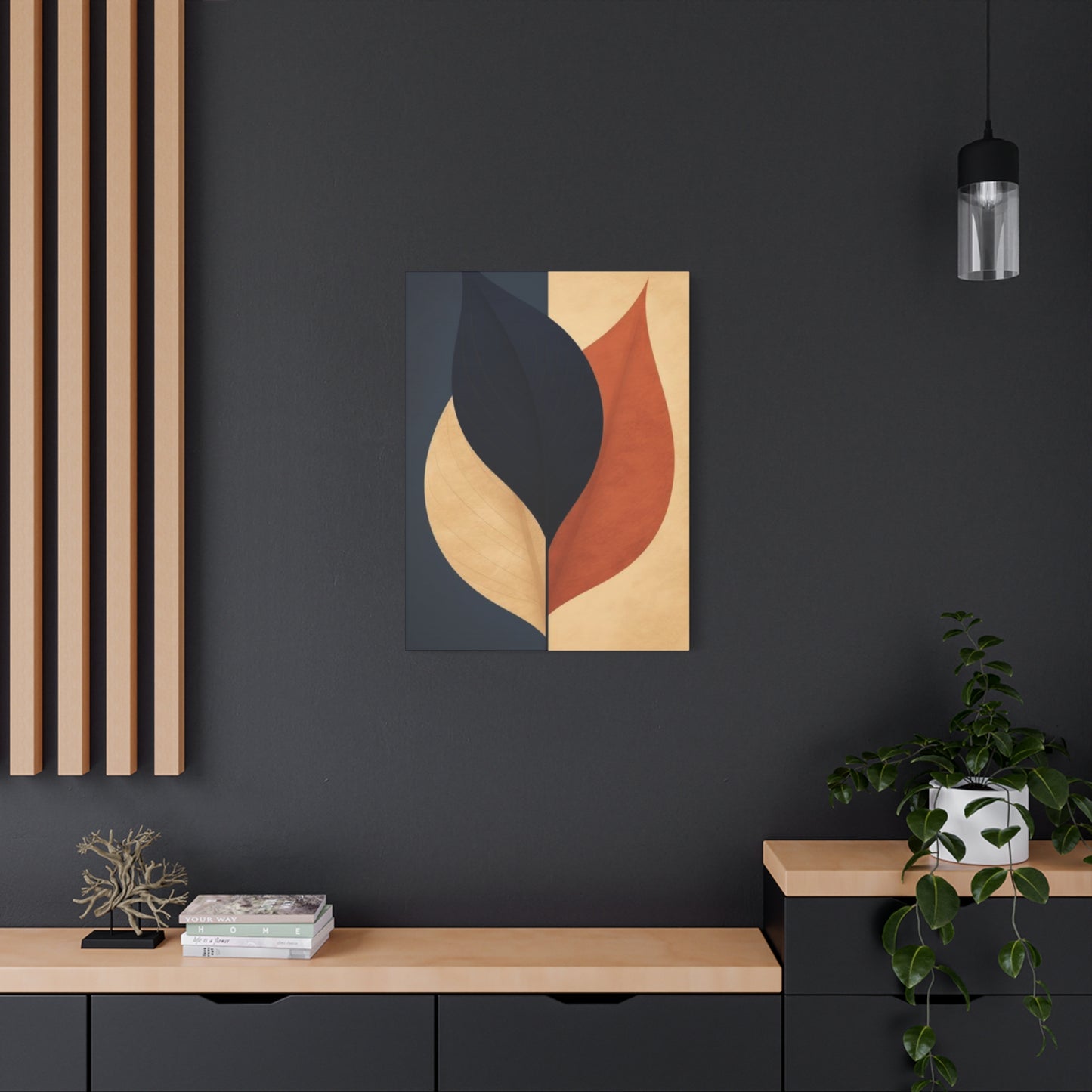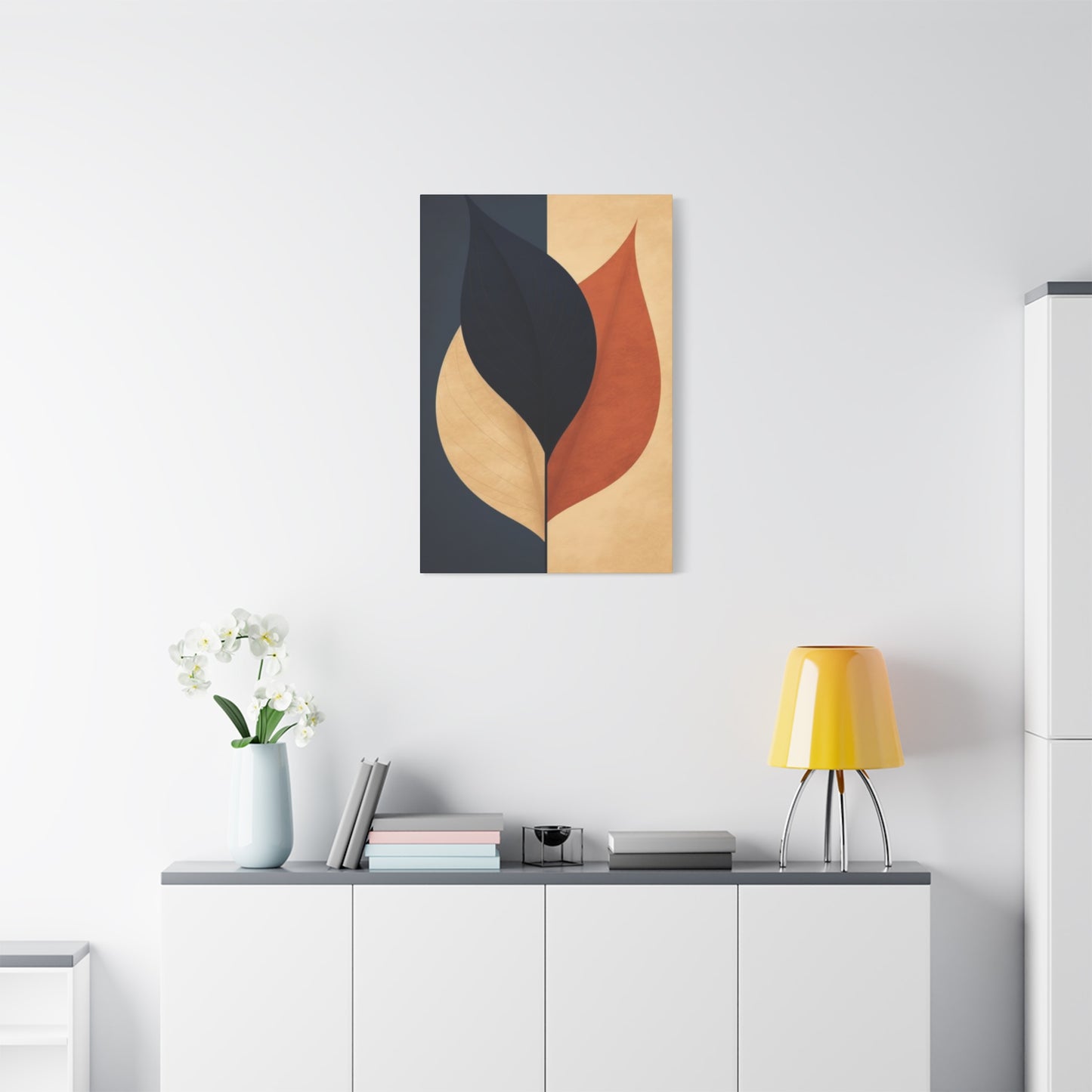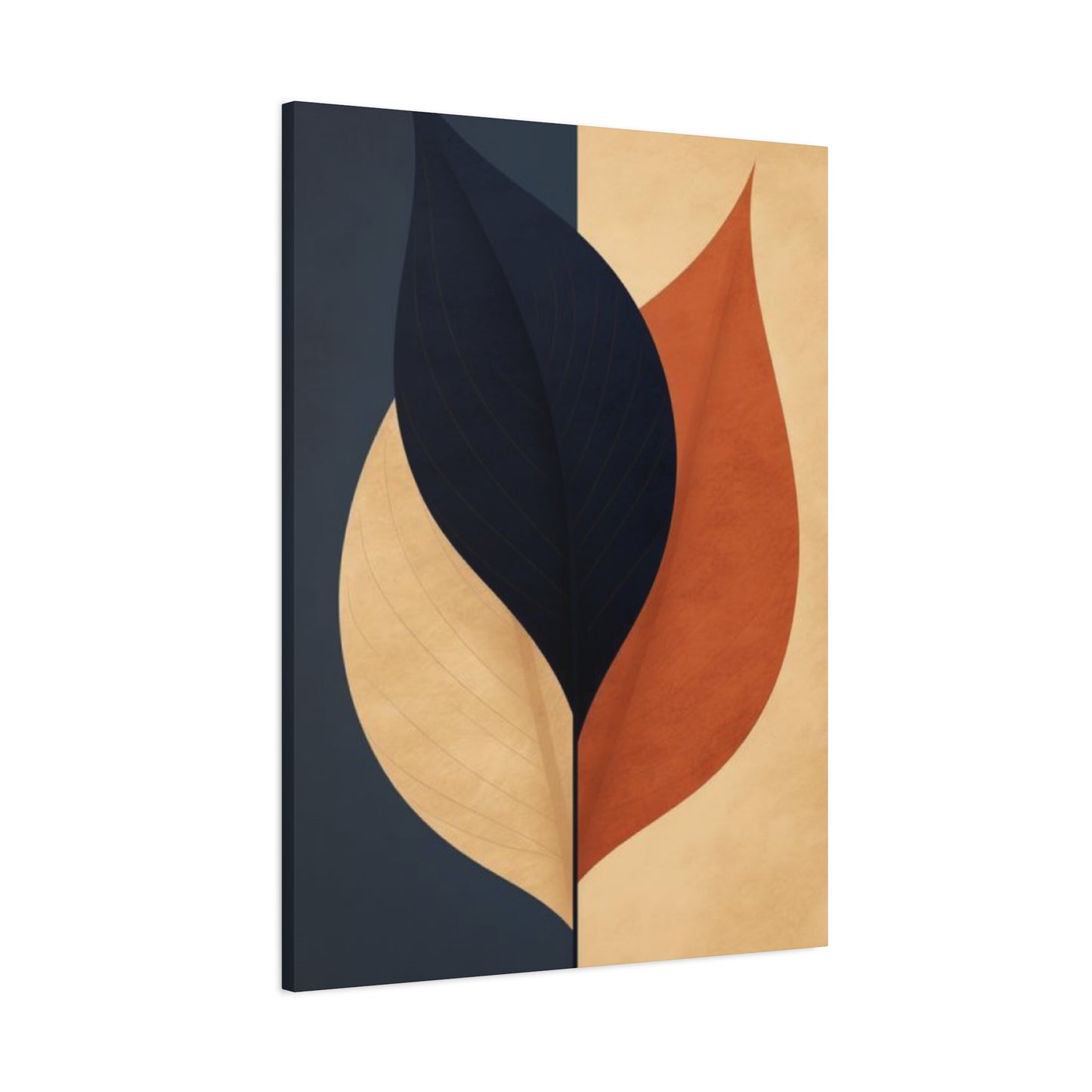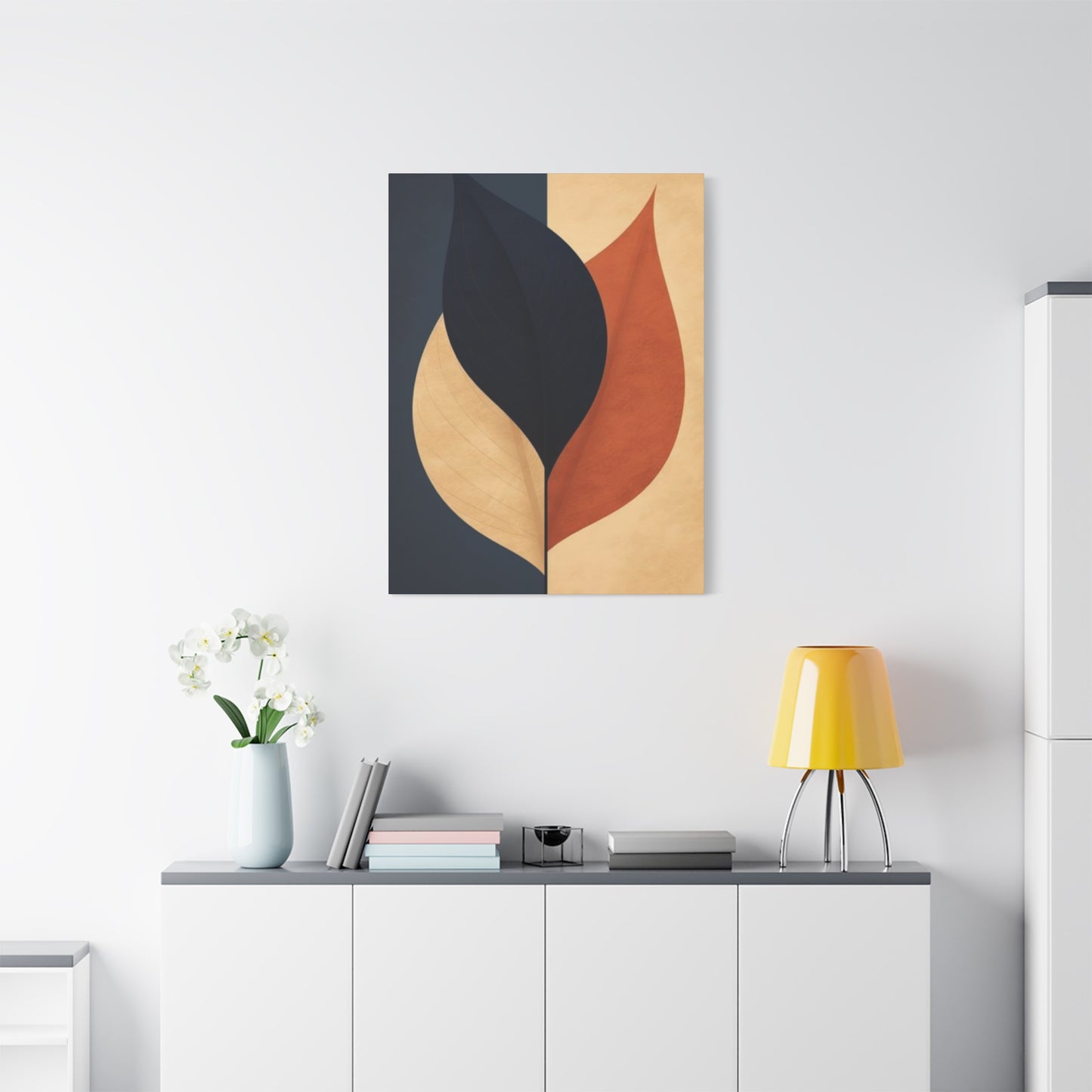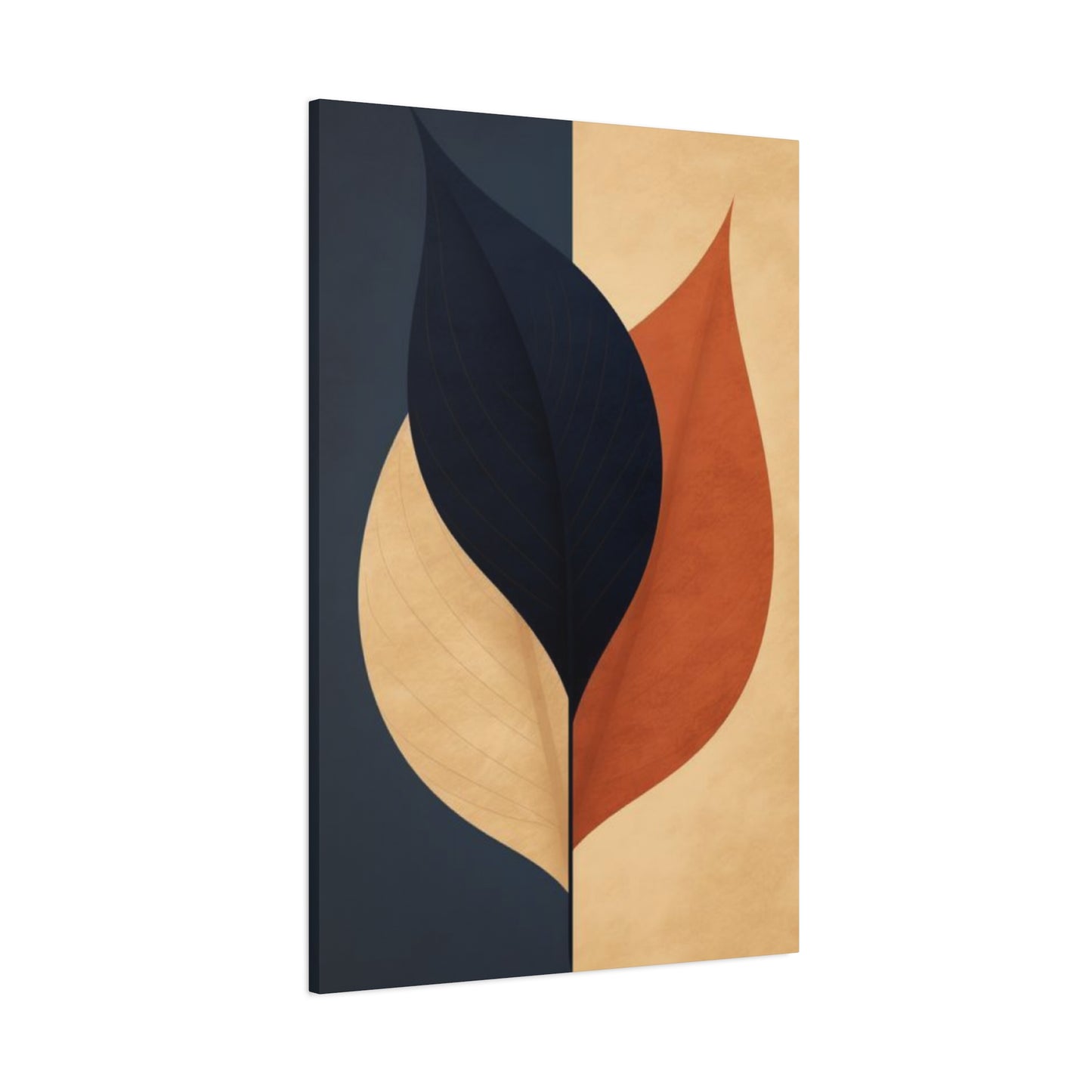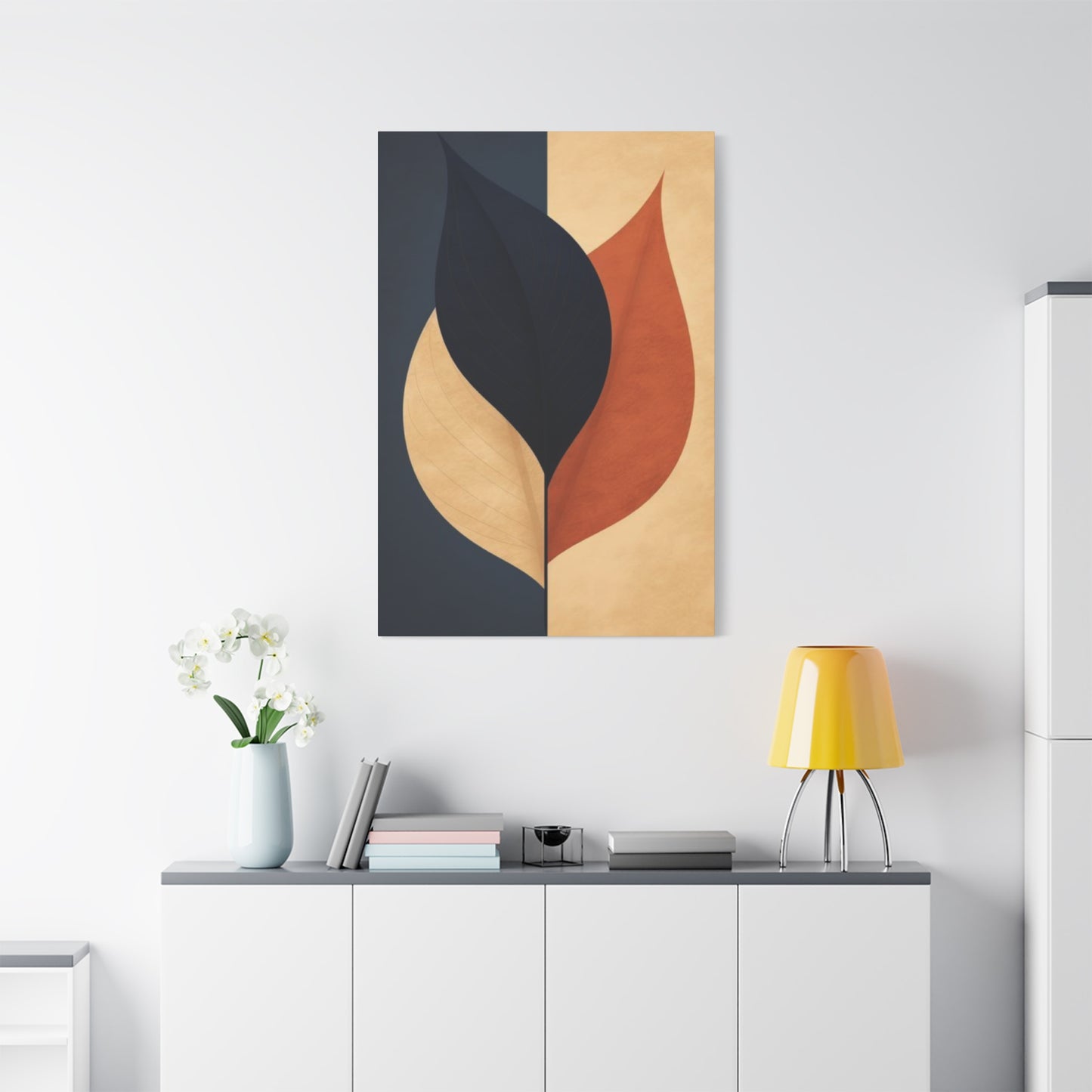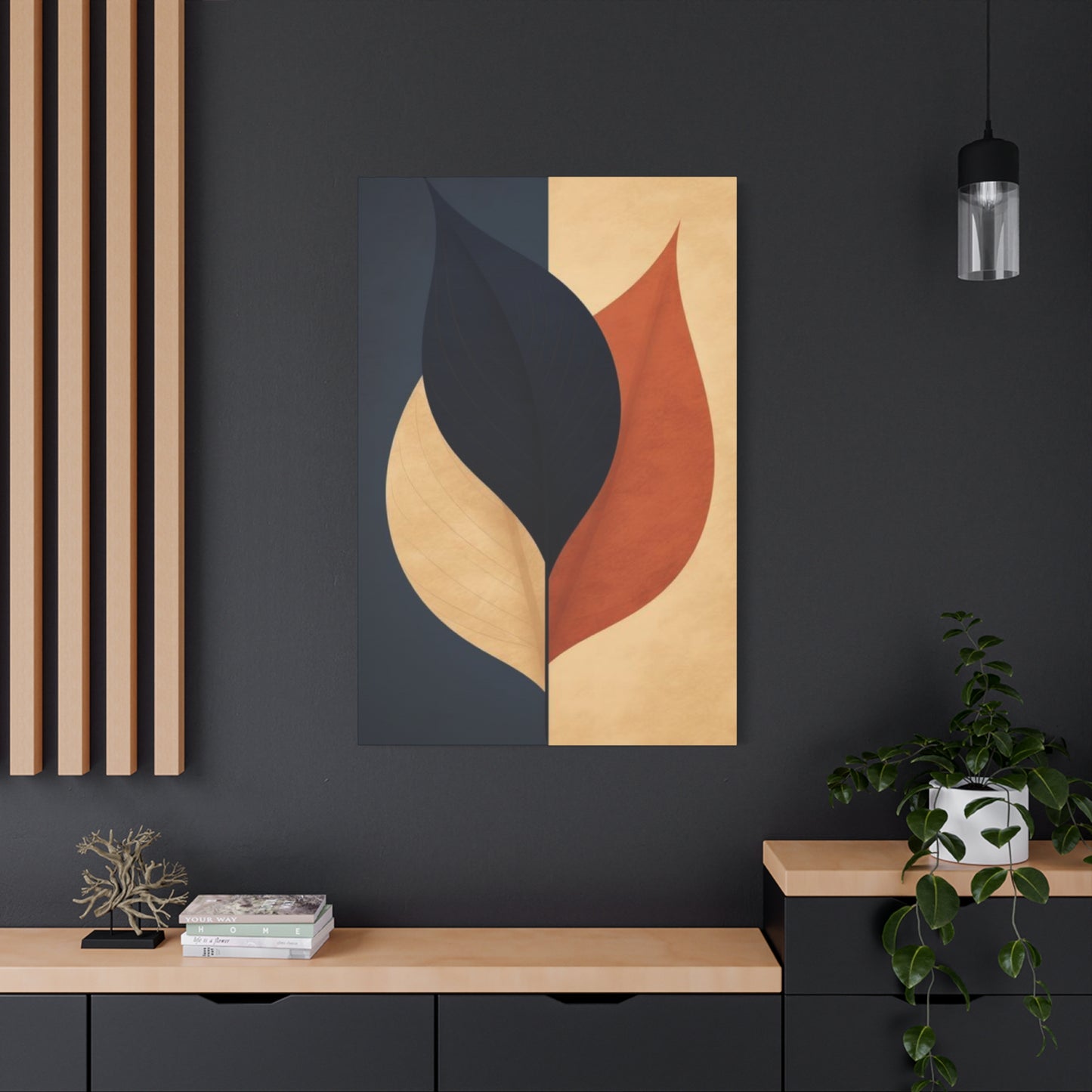Three Leaves Wall Art: Elevating Your Entryway with Natural Serenity
The first impression of any home begins at the entrance, where visitors pause before stepping into your personal sanctuary. What greets them in those initial moments can set the entire mood for their experience within your space. Among the countless decorative options available for adorning an entryway, botanical artwork featuring three leaves has emerged as a timeless choice that resonates with homeowners seeking to blend natural beauty with sophisticated design. This artistic approach captures the essence of organic forms while maintaining a refined aesthetic that complements virtually any interior design philosophy.
When selecting artwork for the space near your front door, the decision carries more weight than one might initially consider. This area serves as a transitional zone between the outside world and your private haven, making it essential to create an atmosphere that feels both inviting and calming. Botanical prints showcasing three delicate leaves offer exactly this balance, bringing elements from the natural world into your home while maintaining a sense of order and intentional design. The simplicity of this motif allows it to serve as a gentle introduction to your home's character without overwhelming visitors or competing with other design elements.
The appeal of leaf-inspired artwork extends beyond mere aesthetics. These pieces carry symbolic meaning that resonates on a subconscious level, evoking feelings of renewal, growth, and connection to the earth. In our increasingly urbanized lives, where many spend the majority of their time indoors surrounded by synthetic materials and artificial lighting, incorporating natural imagery serves as a vital reminder of our intrinsic bond with the living world around us.
How Botanical Artwork Creates Peaceful Entryways
The moment someone crosses your threshold, their nervous system begins processing countless visual cues that inform their emotional response to your space. Artwork featuring three leaves positioned near the entrance works on multiple sensory levels to establish an immediate sense of tranquility. The organic shapes found in leaf forms lack the harsh angles and rigid structures common in urban environments, instead offering curves and natural asymmetry that our minds instinctively associate with safety and comfort. This biological response stems from millions of years of human evolution spent in natural environments where the presence of healthy vegetation signaled resources, shelter, and security.
Beyond this primal response, the specific choice of three leaves rather than a single leaf or a dense collection creates a visual rhythm that feels complete without being cluttered. In design principles, odd numbers tend to create more dynamic and interesting compositions than even numbers, and three represents the smallest odd number that can establish a pattern while still maintaining individuality for each element. This mathematical harmony translates into visual satisfaction that viewers may not consciously recognize but will certainly feel when encountering your entryway.
The color palette typically associated with leaf artwork further enhances the calming effect. Whether rendered in deep forest greens, soft sage tones, muted olive shades, or even neutral beiges and grays that capture the essence of dried botanicals, these hues have been scientifically proven to lower heart rate and reduce stress responses. Green, in particular, sits at the center of the visible light spectrum, making it the easiest color for our eyes to process, which reduces visual fatigue and creates a sense of effortless viewing. When guests encounter these calming colors immediately upon entering your home, their entire body begins to relax, setting a welcoming tone for their visit.
The scale and positioning of three leaves wall art also contributes significantly to the peaceful atmosphere it generates. Unlike busy, complex artwork that demands extended attention and analysis, the simplicity of leaf forms allows for immediate comprehension. Visitors can take in the entire composition within seconds, experiencing its beauty without feeling obligated to study it intensively. This effortless appreciation means the artwork serves its purpose without creating any cognitive load or decision fatigue, allowing guests to transition smoothly from the outside world into your home environment.
Lighting plays a crucial role in how leaf artwork affects the ambiance of an entryway. Whether illuminated by natural daylight streaming through adjacent windows or highlighted by carefully positioned artificial lighting, the shadows and depth created by leaf imagery can add subtle movement and life to the space. During different times of day, the artwork may reveal new details or create shifting shadow patterns that mimic the way real leaves move in gentle breezes, adding an element of dynamic tranquility that keeps the space feeling alive rather than static.
The psychological impact of introducing nature-inspired elements into indoor spaces has been extensively documented through numerous research studies. This concept, known as biophilic design, recognizes that humans possess an innate tendency to seek connections with nature and other forms of life. By incorporating botanical artwork into your entryway, you tap into this fundamental human need, creating an environment that feels inherently more comfortable and restorative. The presence of nature imagery, even in artistic representation, has been shown to reduce stress hormones, lower blood pressure, and improve overall mood within minutes of exposure.
The Visual Simplicity of Botanical Prints
In an era characterized by visual overstimulation and constant digital bombardment, the refined simplicity of three leaves artwork offers a refreshing counterpoint to the chaos of modern life. This style of decoration embraces the philosophy that less can indeed be more, proving that sophisticated design need not rely on complexity or abundance. The clean lines and uncluttered composition inherent in leaf imagery create visual breathing room that allows the eye to rest, making your entryway feel more spacious and intentional rather than crowded or overwhelming.
The beauty of this approach lies in its ability to make a statement without shouting for attention. Where maximalist designs compete for visual dominance through layers of pattern, color, and detail, leaf artwork achieves impact through restraint and purposeful editing. Each element within the composition earns its place, with the negative space around the leaves proving just as important as the botanical forms themselves. This thoughtful use of empty space creates a sense of balance and proportion that registers as deeply satisfying to viewers, even those who might not consciously understand the design principles at work.
Choosing artwork that features exactly three leaves rather than a random assortment demonstrates intentionality in your design choices. This specificity signals to visitors that your home reflects careful thought and aesthetic consideration rather than haphazard decoration. The repetition of the leaf motif three times creates unity and cohesion within the piece while the slight variations between each individual leaf introduce enough diversity to maintain visual interest. This balance between repetition and variation represents a fundamental principle of effective design that translates across all creative disciplines.
The color palette employed in leaf artwork typically embraces a restrained approach that aligns perfectly with contemporary design sensibilities. Whether the piece features monochromatic tones that range from light to dark within a single color family, or employs a limited palette of complementary earth tones, the result feels cohesive and purposeful. This chromatic restraint makes the artwork incredibly versatile, allowing it to integrate seamlessly with existing decor while still maintaining its own distinct presence. The lack of garish or competing colors means the piece will never clash with seasonal decorations, furniture updates, or evolving design preferences.
The format and framing of three leaves artwork further emphasizes its refined nature. Clean, simple frames in materials like light wood, matte black metal, or even frameless mounting options keep the focus squarely on the botanical imagery itself without introducing unnecessary decorative elements. This approach aligns with the current movement toward authentic materials and honest presentation, where the artwork speaks for itself without relying on ornate frames or embellishments to justify its presence on your wall.
Many homeowners appreciate how leaf artwork achieves a sense of elegance without appearing pretentious or unapproachable. Unlike abstract pieces that may require art history knowledge to appreciate or photographic prints that capture fleeting moments, botanical illustrations possess an inherent accessibility that makes them universally appealing. Visitors of all ages and backgrounds can connect with the imagery of leaves, as these forms are familiar and comforting rather than challenging or obscure. This democratic appeal makes leaf artwork an excellent choice for entryways, where the goal is to welcome everyone rather than to display exclusive tastes.
The enduring nature of botanical artwork also speaks to its refined character. While trendy designs come and go with each passing season, leaf imagery has remained consistently popular across centuries and cultures. From ancient botanical illustrations in scientific manuscripts to contemporary digital prints, the essential appeal of capturing plant forms in art has never waned. By choosing this style for your entryway, you invest in a timeless aesthetic that won't feel dated within a few years, making it both a practical and aesthetically sound decision for long-term home decoration.
Welcoming Organic Elements Through Botanical Design
The decision to incorporate nature-inspired artwork into your living space represents more than a decorative choice; it reflects a deeper philosophy about how we want to experience our homes. By featuring three leaves near your entrance, you literally bring the outdoors inside, creating a symbolic and visual connection between the natural world and your domestic sanctuary. This gesture acknowledges our fundamental relationship with the environment while adapting it to suit contemporary indoor living conditions.
The specific imagery of leaves carries rich associations that enhance the welcoming quality of an entryway. Leaves represent the most visible and accessible part of most plants, serving as the interface between the organism and its environment. They capture sunlight, exchange gases, and display the health and vitality of the plant they belong to. When we feature leaf imagery in our homes, we invoke these associations of vitality, exchange, and life-sustaining processes, even if only on a subconscious level. This symbolism makes leaves particularly appropriate for entryways, which themselves serve as interfaces between the external world and our private indoor spaces.
Different types of leaves can be featured in three leaves artwork, each bringing its own character and associations to your entryway. Broad, smooth leaves like those from tropical plants suggest abundance, shade, and lush environments. They create an impression of generous welcome and plenty. Delicate, compound leaves from ferns or similar plants evoke more intimate, forest floor settings, bringing a sense of sheltered calm and gentle mystery. Simple leaves with elegant veining showcase the intricate beauty found in seemingly straightforward natural forms, celebrating both simplicity and complexity in a single image. The choice of leaf type allows you to fine-tune the specific mood and character your entryway projects.
The seasonal associations of leaves add another layer of meaning to this decorative choice. Spring leaves might appear fresh and bright, colored in new greens that speak of beginnings and renewal. Summer leaves in their full maturity suggest abundance, peak vitality, and the celebration of life in its fullness. Autumn leaves transitioning to warm golds, oranges, and reds embrace the beauty of change and transformation. Even winter leaves, whether evergreen or captured in their dried, skeletal form, offer lessons about endurance, structure, and finding beauty in every season. By selecting artwork that resonates with your personal seasonal preferences, you can embed additional meaning into your entryway design.
The textures implied or actual in leaf artwork contribute to the naturalistic feeling they bring to a space. Some pieces might feature smooth, matte finishes that suggest the waxy coating of certain leaves. Others might incorporate embossing or raised elements that create subtle three-dimensional relief, inviting not just visual appreciation but potentially tactile engagement. The play of light across these surfaces throughout the day can create ever-changing visual effects that mimic the way sunlight filters through real foliage, adding a dynamic quality that keeps the artwork feeling fresh and engaging rather than static.
Scale considerations when featuring leaf artwork can dramatically affect how successfully it brings nature into your home. Oversized leaves presented at larger than life scale create dramatic impact and allow viewers to appreciate details they might overlook in actual plants. This magnification approach transforms the familiar into something newly remarkable, encouraging fresh appreciation for forms we typically take for granted. Alternatively, leaves presented at actual size or smaller can feel more intimate and personal, like a carefully preserved botanical specimen that invites close inspection and quiet contemplation. The choice depends on the overall scale of your entryway and the type of impression you wish to create.
Sophisticated Styling for Entry Areas
The space around your front door presents unique decorating challenges and opportunities that make it distinctly different from other areas in your home. This zone must accommodate practical needs like coat storage, key deposits, and sometimes shoe removal while simultaneously serving as the aesthetic introduction to your living space. Three leaves artwork addresses these dual requirements by providing visual interest that elevates the area without adding physical clutter or interfering with the practical functions the space must serve.
When positioning leaf artwork in an entryway, height placement deserves careful consideration. The center of the artwork should typically align with average eye level, which falls somewhere between 57 and 60 inches from the floor in most residential spaces. This positioning ensures that the piece can be comfortably viewed by people of varying heights without requiring them to crane their necks or stoop down. However, if your entryway features particularly high ceilings or architectural elements that draw the eye upward, you might adjust this rule slightly, raising the artwork to better integrate with the vertical proportions of the space.
The relationship between your three leaves wall art and other elements in the entryway requires thoughtful orchestration. If you have a console table beneath the artwork, the frame's bottom edge should typically sit 6 to 12 inches above the table surface, creating distinct separation while maintaining visual connection between the two elements. Objects placed on the console should relate to the artwork in scale and style without exactly matching it. For instance, a simple vase with fresh or dried botanicals might echo the natural theme of the leaf art, while books, a decorative bowl, or a table lamp add variety and function to the vignette.
Lighting specifically directed at leaf artwork can dramatically enhance its impact in an entryway. Picture lights mounted above the frame or recessed ceiling spots angled to illuminate the piece ensure that it remains visible and beautiful even during evening hours when natural light fades. The type of bulb you choose affects how colors appear in the artwork; warm white bulbs (2700-3000K) create a cozy, inviting glow that enhances earthy tones, while daylight bulbs (5000-6500K) provide crisp illumination that might better suit modern spaces with cooler color schemes. Dimmer switches offer the flexibility to adjust lighting levels for different times of day and occasions.
The surrounding wall color provides the immediate context within which your leaf artwork exists, making it a crucial consideration in the overall effect. Neutral backgrounds in whites, soft grays, or warm beiges allow the artwork to stand out clearly without competition, creating a gallery-like presentation that emphasizes the art itself. Deeper wall colors can create more dramatic contrast, especially with lighter-toned leaf prints, establishing a bold, confident aesthetic. Some homeowners choose to paint the entryway wall in a color that appears within the leaf artwork, creating a harmonious, envelope effect that feels intentional and cohesive.
Grouping three leaves artwork with other pieces requires restraint and careful planning to avoid visual chaos in the typically limited square footage of an entryway. If you wish to create a small gallery wall, limit the total number of pieces to three or five items, maintaining odd-number composition principles. Ensure all pieces share some unifying element, whether that's frame style, color palette, subject matter theme, or format size. Arrange them with consistent spacing between frames, typically 2 to 3 inches, and plan the layout on the floor before committing to wall holes, adjusting until the arrangement feels balanced and intentional.
Seasonal styling offers opportunities to refresh your entryway's appearance without replacing the permanent leaf artwork. During spring, you might add fresh flowers that echo the green tones in the piece. Summer could bring in woven textures and lighter fabrics that complement the natural theme. Autumn invites warm-toned accessories and perhaps small pumpkins or gourds that create dialogue with the botanical artwork. Winter styling might include evergreen branches, pinecones, or simple white candles that maintain the natural theme while acknowledging the season. These rotating elements keep your entryway feeling current and engaged with the passing year without requiring major decorative overhauls.
Bringing Vitality Into Entrance Spaces
The entryway to your home serves as more than a simple passage; it represents the threshold between public and private realms, carrying psychological significance that affects both residents and visitors. When this space incorporates imagery of fresh, healthy leaves, it immediately communicates vitality, renewal, and life force. These associations occur partly on a conscious level, where we recognize and appreciate the beauty of botanical forms, and partly on a deeper, instinctive level where our evolved responses to vegetation trigger positive emotional and physiological reactions.
The concept of freshness that leaf imagery evokes taps into universal human desires for cleanliness, renewal, and new beginnings. In nature, fresh leaves signal spring's arrival, new growth after pruning, or a plant's healthy response to favorable conditions. These associations transfer to the domestic realm, where leaf artwork suggests a home that's well-tended, thoughtfully maintained, and alive with positive energy. Visitors perceiving these subtle cues may unconsciously conclude that they're entering a space where attention to detail and care are valued, setting expectations for the quality of experience they'll have throughout their visit.
Color psychology plays a significant role in how leaf artwork brings freshness to entryway decor. The various greens typically featured in botanical prints have measurable effects on human perception and mood. Light, spring greens convey youth, energy, and optimism, creating an uplifting first impression. Medium greens suggest balance, harmony, and stability, providing reassurance and comfort. Deep, forest greens communicate strength, endurance, and connection to established, mature nature. Even when leaf artwork employs non-realistic colors—such as black and white photography, sepia tones, or stylized treatments in unexpected hues—the form itself still carries associations with vegetation and therefore with life and growth.
The implied motion in leaf imagery contributes to the sense of freshness and vitality. Even in static artwork, the curves and flowing lines of leaf forms suggest gentle movement, as if caught in a soft breeze. This implied motion keeps the artwork from feeling completely static or lifeless, instead suggesting that it captures a moment in time within an ongoing process of growth and change. Our eyes tend to follow the curves and veins in leaf structures, creating a sort of visual journey that engages our attention without demanding intense focus. This gentle visual activity feels refreshing rather than exhausting, making it ideal for an entryway where people are transitioning between activities rather than settling in for extended viewing.
The association between leaves and air quality adds another dimension to the freshness they bring to a space. In reality, leaves perform the crucial function of converting carbon dioxide to oxygen through photosynthesis, literally refreshing the air around them. While artwork obviously cannot perform this function, the visual presence of leaves can trigger associations with clean, oxygen-rich air, perhaps even creating a subtle perception that the space feels more breathable and less stuffy. This psychological effect, while not based on actual air quality changes, can nonetheless affect how comfortable and welcome people feel in your entryway.
Seasonal evergreen leaves offer a particular type of freshness that persists year-round, making them an excellent choice for homeowners who want botanical artwork that doesn't feel tied to specific seasons. Plants like eucalyptus, magnolia, olive branches, and various ferns maintain their foliage throughout the year, symbolizing endurance, constancy, and perpetual renewal. Featuring these types of leaves in your entryway artwork creates a sense of timeless freshness that doesn't fluctuate with the calendar, providing visual stability while still connecting to natural themes.
The texture and finish of leaf artwork also affect the sense of freshness it conveys. Glossy finishes might suggest the waxy coating of healthy, well-hydrated leaves, catching and reflecting light in ways that feel lively and dynamic. Matte finishes can evoke the soft, velvet-like texture of certain leaves or the powdery coating that protects some plants from excessive sun exposure. Watercolor techniques that allow colors to blend and bleed at edges create a soft, fresh quality reminiscent of morning dew on foliage. The choice of technique and finish allows you to calibrate the specific type of freshness your artwork communicates, from crisp and energizing to soft and dewy.
Striking Visual Impact With Minimal Elements
The effectiveness of three leaves wall art demonstrates a fundamental principle of design: dramatic impact need not require elaborate complexity. By focusing on a carefully selected, refined subject and presenting it with intention and quality, a simple composition can command attention and create lasting impressions that rival or even surpass busier, more complicated artworks. This approach requires confidence in restraint, trusting that what you choose to include carries sufficient interest and beauty to justify what you choose to leave out.
The power of repetition with variation becomes evident when examining why three leaves create such satisfying compositions. The repetition of the leaf form establishes pattern and unity, giving the eye familiar shapes to recognize and appreciate. However, the natural variation between individual leaves prevents monotony, as each leaf likely differs in size, orientation, vein pattern, or edge detail. This balance between consistency and diversity creates visual rhythm that feels neither chaotic nor boring, striking the delicate equilibrium that characterizes memorable design.
Negative space, often called white space in design parlance, plays a crucial role in making leaf artwork feel striking despite its simplicity. The areas around and between the leaves are not empty in any negative sense; rather, they provide visual rest that allows the eye to fully appreciate the complexity and beauty of the leaf forms themselves. Without adequate negative space, even beautiful botanical illustrations can feel cramped and overwhelming. The generous use of empty space in well-designed leaf artwork creates an impression of luxury and sophistication, as it demonstrates that the designer felt no need to fill every inch with imagery or decoration.
The level of detail captured in leaf artwork contributes significantly to its ability to make an impact with minimal elements. A simple silhouette reduces the leaf to its most essential outline, creating bold, graphic impact that registers immediately even from a distance. Illustrations that include vein structures invite closer inspection, rewarding viewers who take time to examine the piece more carefully. Photographs or highly detailed drawings that capture texture, subtle color variations, and the play of light across the leaf surface offer nearly endless discoveries for the attentive observer. The level of detail you choose should align with both your personal preferences and the viewing distance typical in your entryway—more detail suits spaces where people pause and study the art, while bolder, simpler forms work better in pass-through areas.
Contrast creates one of the most effective tools for making simple artwork feel striking and important. High contrast between the leaves and their background ensures the forms read clearly and command attention. Black leaves on white backgrounds or vice versa create maximum contrast and modern, graphic impact. More subtle approaches might feature deep green leaves on cream backgrounds or sepia-toned leaves on soft gray, creating gentler but still effective contrast that feels sophisticated and refined. The amount of contrast you choose dramatically affects the energy and intensity of the artwork, giving you control over whether it feels bold and energizing or calm and subtle.
The line quality in leaf artwork affects its overall impression and impact. Clean, crisp edges create a contemporary, almost technical feeling that aligns with modern and minimalist aesthetics. Softer, slightly blurred edges suggest a more romantic, organic approach that might suit transitional or traditional spaces. Hand-drawn or painted edges with visible irregularities bring an artisanal quality that communicates authenticity and human touch. Even these subtle variations in how the leaf edges are rendered can significantly affect whether the artwork feels striking in a bold, graphic sense or in a more gentle, artistic manner.
Scale manipulation represents another strategy for creating impact with simple leaf imagery. Presenting leaves at greatly enlarged scale transforms familiar forms into almost abstract compositions, forcing viewers to see common objects in new ways. This magnification reveals details typically invisible to the naked eye, such as the intricate network of veins, subtle texture variations, and the architectural structure underlying what might seem like a simple, flat form. Alternatively, presenting leaves at reduced scale can create a delicate, precious quality that invites intimate viewing and close approach. Either extreme creates more impact than simply reproducing leaves at their actual size, as it represents a deliberate artistic choice that transforms reality rather than merely documenting it.
Perfect Harmony for Peaceful Doorways
The concept of a calm entrance space carries particular significance in our modern world, where many people experience high levels of stress in public and professional settings. Your home's entryway serves as the decompression chamber where these external pressures can begin to release, allowing you to transition into a more relaxed, authentic state. Three leaves artwork contributes to this essential function by providing visual elements that actively promote tranquility rather than adding to sensory overload.
The psychological concept of visual weight helps explain why leaf artwork creates such peaceful impressions. Unlike artwork with heavy, dense compositions that can feel imposing or demanding, the relatively light visual weight of three leaves allows the piece to integrate into the space without dominating it. The organic forms and generous negative space prevent the artwork from feeling oppressive or overwhelming, instead creating a sense of openness and ease. This lighter visual weight makes the entryway feel more spacious and breathing, contributing to the overall sense of calm.
Symmetry and asymmetry both play roles in creating ideal compositions with three leaves. Perfect symmetry, where one leaf sits centered with two flanking leaves in mirror positions, creates formal balance that feels stable and orderly. This approach suits traditional and classical design schemes where predictability and structure communicate refinement and control. Asymmetrical arrangements, where the three leaves are positioned with deliberate irregularity, feel more dynamic and contemporary while still maintaining overall visual balance. This approach better reflects how leaves actually grow in nature, introducing an organic quality that can feel more relaxed and approachable. The choice between these arrangements allows you to calibrate the specific type of tranquility you want to create—formal and composed versus easy and natural.
The absence of jarring elements in well-designed leaf artwork contributes significantly to its peaceful quality. No harsh diagonal lines slash across the composition. No aggressive colors demand attention or trigger strong emotional responses. No complex patterns require mental processing or create visual confusion. Instead, the artwork presents gentle curves, soothing colors, and simple forms that the brain can comprehend and appreciate without effort. This effortlessness is key to creating tranquility—when viewing art requires no mental strain or decision-making, it allows the mind to rest rather than engage.
The time period represented or evoked by leaf artwork affects how peaceful it feels. Contemporary, graphic interpretations might feel clean and uncluttered, perfect for modern spaces seeking tranquility through minimalism. Vintage botanical illustrations in the style of 19th-century scientific drawings bring a sense of timelessness and scholarly calm, as if the viewer has entered a private study or library. Impressionistic watercolor treatments create soft, dreamy qualities that promote relaxation through their gentle, unfocused aesthetics. Each approach to presenting leaf imagery offers a different path to tranquility, allowing you to choose the one that best aligns with your personal sense of what peace looks and feels like.
The cultural associations of leaves contribute additional layers of meaning that can enhance peaceful feelings. In many spiritual and philosophical traditions, leaves symbolize life, growth, healing, and connection to nature. The practice of forest bathing, originating in Japan, recognizes that time spent among trees and vegetation provides measurable health benefits including reduced stress hormones and improved mood. While artwork cannot replicate the full experience of being in a forest, it can serve as a reminder and symbol of that connection, perhaps even triggering some of the positive associations we've developed with natural environments. For people who value these traditions or simply intuitively respond to natural imagery, leaf artwork becomes more than decoration—it becomes a tool for cultivating inner peace.
The permanence that quality leaf artwork provides contributes to a sense of calm continuity in the ever-changing flow of daily life. Unlike fresh flowers that wilt and need replacing, or trendy decorations that quickly feel dated, well-chosen botanical prints can remain relevant and beautiful for years or even decades. This stability creates a reliable touchstone in your entryway, something familiar to return to at the end of each day. Knowing that this calming visual element will be there to greet you provides a subtle but meaningful form of comfort, a small constant in an often unpredictable world.
Establishing Organic Atmosphere With Plant Imagery
Creating an authentic natural atmosphere in your home through artwork requires attention to both the obvious and subtle details that make botanical imagery feel genuine and connected to the living world. While three leaves artwork cannot photosynthesize or grow, it can evoke the presence of real plants and the feelings associated with green, growing spaces. This atmospheric quality transforms a simple decorative choice into an environmental enhancement that affects how the entire entryway feels and functions.
The choice between realistic and stylized representations significantly impacts the type of natural atmosphere created. Photographic prints of actual leaves bring scientific accuracy and documentary quality that feels grounded in observable reality. These pieces might appeal to those who appreciate nature in its unadorned truth, without artistic interpretation or romanticization. Stylized illustrations, whether hand-drawn, painted, or digitally created, introduce the artist's perspective and interpretation, creating a nature filtered through human creativity. This approach might feel more personal and unique, reflecting not just the beauty of leaves themselves but the artistic tradition of capturing and celebrating botanical forms.
The environment implied in leaf artwork contributes to atmospheric effect. Leaves shown with water droplets or morning dew suggest cool, fresh moments in the garden or forest. Leaves backlit by sun imply warm afternoon light filtering through canopy. Leaves shown against dark backgrounds might evoke evening garden walks or shade-loving understory plants. These contextual details, even when subtle or minimal, add narrative quality that helps viewers mentally place themselves in natural settings, enhancing the sense of bringing outdoors inside.
The season implied or depicted in leaf artwork affects what type of natural atmosphere it creates. Spring's tender new leaves bring associations with renewal, awakening, and fresh starts—perfect for homes undergoing transitions or for homeowners who view their space as constantly evolving. Summer's full, lush foliage suggests abundance, peak vitality, and celebration of life in full bloom—ideal for homes that embrace maximalism within minimalist framework or that serve as gathering places for friends and family. Autumn's changing leaves introduce warmth, transformation, and the beauty found in impermanence—suited to homes that celebrate natural cycles and find meaning in change. Winter's evergreens or preserved dried leaves offer quiet endurance and subtle beauty—perfect for those who appreciate stillness and contemplation.
The materiality of the artwork itself can enhance or detract from natural atmosphere. Prints on thick, textured paper might suggest the organic quality of plant fiber, especially papers made from cotton, bamboo, or other plant sources. Canvas prints bring texture and depth that feel more substantial and craft-oriented. Metal prints create surprisingly organic effects through their luminous quality and how they reflect light, while acrylic or glass mounting creates depth and protection that allows the botanical image to appear suspended in space. Each material choice brings its own character to the piece, affecting how successfully it evokes natural atmosphere.
The surrounding design elements in your entryway either support or undermine the natural atmosphere created by leaf artwork. Natural materials like wood furniture, woven baskets, ceramic vases, and natural fiber rugs reinforce the organic theme, creating a cohesive environment where the botanical artwork feels perfectly at home. Metallic accents in brass, copper, or bronze can complement natural themes through their earth-derived origins and warm tones. Even in predominantly modern spaces with clean lines and contemporary materials, the natural atmosphere of leaf artwork can thrive when design choices respect and frame rather than compete with the botanical focus.
Scent creates a powerful but often overlooked dimension in establishing natural atmosphere. While artwork itself produces no fragrance, pairing leaf wall art with subtle natural scents can dramatically enhance the overall environment. Essential oil diffusers featuring plant-based scents like eucalyptus, pine, cedar, or lavender create olfactory connections that reinforce the visual message of the botanical artwork. Fresh or dried botanicals displayed near the artwork—a small vase of eucalyptus stems, a bowl of pinecones, or dried lavender bundles—provide authentic plant presence that complements the artistic representation on the wall. These multisensory approaches create more complete and convincing natural atmospheres than visual elements alone can achieve.
Arranging Your Entry With Botanical Wall Pieces
The practical logistics of installing and arranging leaf artwork in your entryway require consideration of both aesthetic and functional factors. Unlike living room or bedroom walls where artwork primarily serves decorative purposes, entryway walls must accommodate the unique demands of this high-traffic transition zone. Successful styling integrates the artwork seamlessly into this mixed-use space, allowing it to fulfill its aesthetic mission while respecting the practical needs of daily comings and goings.
Wall selection within the entryway deserves careful thought before committing to nail holes and artwork placement. The wall immediately opposite the front door creates maximum impact, as it's the first thing visitors see when entering and the last thing residents see when leaving. This prominent position suits artwork that you want to serve as a focal point and introduction to your home's aesthetic. Side walls flanking the entry door offer alternative locations that feel somewhat less formal and prominently displayed but still benefit from natural light if the door includes windows or sidelights. The wall behind a console table or bench represents the most traditional placement, creating a clear relationship between furniture and wall decor that helps ground the composition.
Hardware selection affects both the security of your installation and the visual presentation of the artwork. Picture hooks rated for appropriate weight provide reliable support while keeping hardware relatively minimal and discreet. For heavier pieces, wall anchors or studs provide necessary support to prevent accidents and damage. French cleats offer excellent stability for larger works and allow easy removal and reinstallation if you decide to rearrange. Some contemporary hanging systems use rails or cables that remain visible, creating an intentional gallery aesthetic that works particularly well in modern spaces. The hardware choice should reflect both practical requirements and aesthetic preferences, remaining invisible when that serves the design or making an intentional style statement when that approach better suits your vision.
The relationship between artwork and architectural features requires thoughtful navigation. Crown molding, chair rails, wainscoting, and other trim elements create horizontal lines that artwork can either align with or deliberately contrast against. Aligning the artwork's top or bottom edge with existing architectural lines creates visual harmony and makes the piece feel integrated into the home's bones. Alternatively, allowing artwork to break free from these horizontal divisions can create dynamic tension that makes the piece feel more important and independent. Windows, doorways, and other openings near the artwork placement affect available wall space and visual flow, requiring you to consider how the leaf artwork relates to these features.
Entryway dimensions and proportions significantly influence artwork sizing decisions. In compact entries measuring just a few feet wide, oversized artwork might overwhelm the space, making it feel even smaller and more cramped. Conversely, artwork that's too small can appear tentative and insignificant, failing to establish any meaningful presence. A general guideline suggests artwork should fill roughly two-thirds to three-quarters of the available wall width above a piece of furniture, or about half to two-thirds of the width on an open wall without furniture below. However, these proportions remain flexible based on ceiling height, room dimensions, and personal aesthetic preferences.
Conclusion
In conclusion, Three Leaves Wall Art offers an exceptional way to elevate your entryway, infusing it with natural serenity and calming beauty. The symbolism of leaves—often associated with renewal, growth, and the cycles of nature—makes them a perfect choice for a space that serves as the threshold to your home. Whether you choose a minimalist design, a watercolor effect, or more intricate representations, the imagery of three leaves in art can transform your entryway into a peaceful, welcoming space. This subtle yet striking piece not only enhances your home’s aesthetic but also sets the tone for the warmth and tranquility found within.
One of the most captivating qualities of three leaves as a motif is its balance and harmony. In many cultures, the number three symbolizes completeness and stability, making it a thoughtful design choice for the entryway—an area that represents both the physical and symbolic entrance to your home. The trio of leaves creates a sense of unity, as if each individual leaf complements the others, creating a cohesive and peaceful visual statement. This symmetry and balance in design can make the entryway feel more grounded, ensuring that your guests are immediately met with a sense of calm and harmony as they enter.
Furthermore, the use of leaves in wall art brings nature indoors, which has been shown to have a positive impact on mood and well-being. Natural elements are known to reduce stress, increase feelings of calm, and even enhance creativity. In an entryway, where first impressions are made, the inclusion of three leaves wall art invites visitors to feel at ease, creating a space that is not only aesthetically pleasing but also emotionally uplifting. The subtle beauty of leaves in varying shades of green, gold, or even autumn hues can instantly evoke a sense of peace, transforming the entryway from a transitional space into an oasis of tranquility.
The simplicity of the leaf motif also makes it versatile, adapting to various interior styles with ease. Whether your home leans more toward modern, rustic, or traditional design, the gentle curves and organic forms of leaves can complement any setting. A black-and-white design can evoke a more contemporary, minimalist feel, while lush green or vibrant fall-colored leaves might suit a more earthy or bohemian aesthetic. The simplicity of the leaf itself—often delicate, graceful, and inherently beautiful—creates a focal point without overwhelming the space, making it a perfect choice for an entryway where the goal is to welcome rather than dominate.
Another compelling aspect of three leaves wall art is the opportunity for storytelling and personalization. Each leaf can symbolize different elements of nature, growth, or personal values. For example, one leaf could represent strength, another resilience, and the third peace—creating a personal narrative for the space. This symbolic interpretation allows homeowners to infuse deeper meaning into their entryway, transforming a simple piece of art into a reflection of their personality, life journey, or even the values they want to express to guests. The entryway becomes not just a space for greeting but also an introduction to the soul of the home.
In addition to its aesthetic appeal, three leaves wall art can also have a subtle yet profound effect on the overall flow and energy of your home. According to feng shui principles, the front entryway is an important space that sets the tone for the entire household. Incorporating natural imagery, such as leaves, is said to invite positive energy, balance, and vitality into the home. The three leaves, with their connection to growth and nature, symbolize new beginnings and an open, harmonious environment. Their presence in the entryway can help create a balanced flow of energy that extends throughout the rest of the home.
The material and medium of the three leaves wall art can also further enhance its effect. Whether it is painted on a canvas, printed on a wood panel, or framed in a sleek metal frame, the texture and materials can add layers of interest. For example, a wooden-framed piece with a soft watercolor design evokes a rustic, natural feel, while a more abstract, geometric take on the leaves might suit a contemporary or industrial space. Each material choice can subtly influence the overall atmosphere of the entryway, contributing to the desired vibe—whether calming, elegant, or grounded.
Finally, the decision to place three leaves wall art in the entryway isn’t just about decoration; it’s about creating an experience. It’s about setting the tone for what lies ahead, offering a moment of peace and reflection as visitors enter your home. The entryway is the first glimpse into your home’s character, and the art you choose speaks volumes. A piece featuring three leaves offers a serene, inviting atmosphere, making it clear that your home is a sanctuary of warmth, natural beauty, and thoughtful design.
In summary, Three Leaves Wall Art is a beautiful and meaningful choice for elevating your entryway. It brings nature’s calmness, balance, and symbolism into your home, transforming an often-overlooked space into one of quiet elegance. The harmonious representation of three leaves speaks to both aesthetic and emotional values, creating a welcoming environment for guests while fostering a sense of serenity for the homeowner. Through its simplicity and natural beauty, this artwork enhances the entryway as both a space of transition and a representation of the growth, peace, and vitality that define your home. Whether in soft, muted tones or vivid, colorful hues, the three leaves wall art serves as a perfect embodiment of the tranquility and warmth you want your home to convey.




















